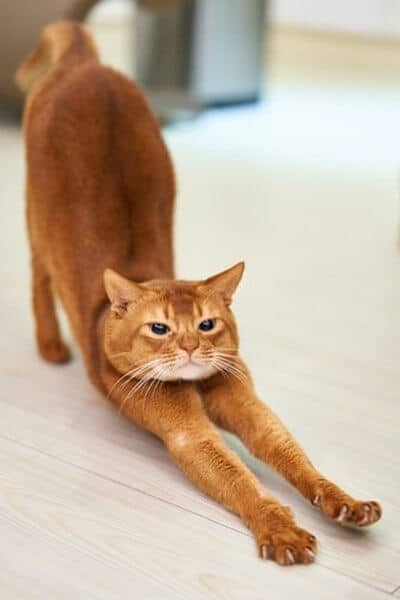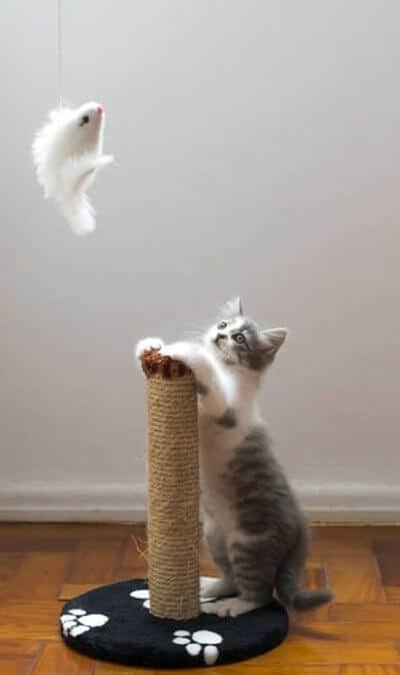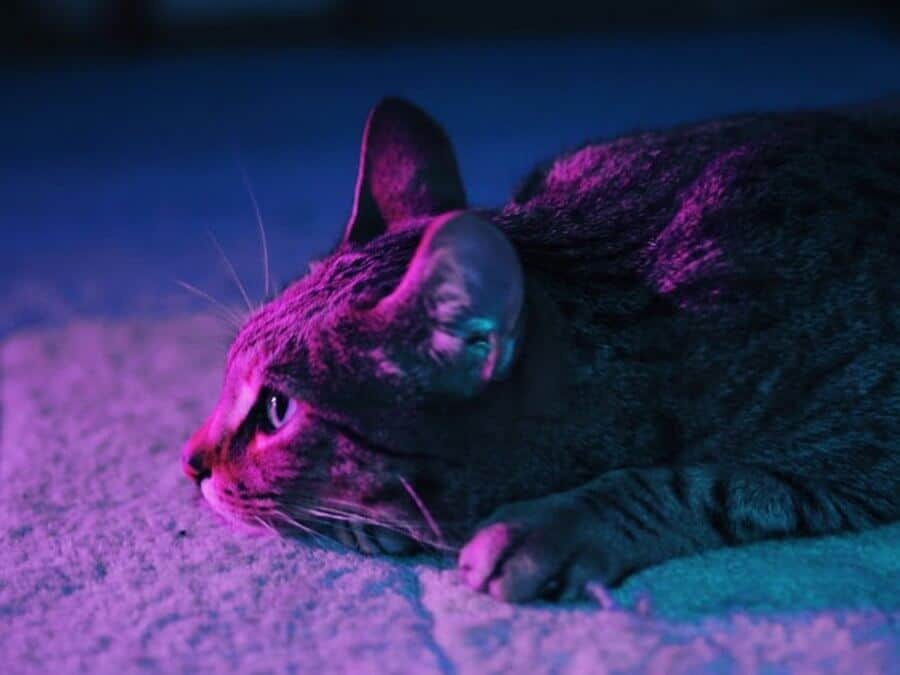When observing your feline friend, you may notice from time to time bits of nails lying around the home. This is your furry friend shedding its nails, read on to find out more about what this means for your cat.
Cat nail shedding is a natural occurrence for all cats no matter the breed. When a cat loses the layers of the outer nail, known as the sheath, it can be compared to humans clipping their nails. This is why you will commonly see a cat clawing at a scratching post, trees, and sometimes furniture.
Another way a cat will trim its nails is by biting at stubborn bits that may not come off as easily when they go to scratch on an object. Although every time they scratch on a scratching post does not necessarily mean they are doing it to trim their nails.
Some simply do it to help stretch, as you likely find that your cat goes into an arched position when doing so. In some cases they will also do it to sharpen the nails, some cats will even use a hard surface such as concrete or asphalt to do this.
Should I Trim My Cats Nails?
Generally, you do not need to trim your cats’ nails, this is advised to leave to your local veterinarian if you are considering doing this. As you will find with dogs, cats have a quip at the center of their nails.
Due to this, is why you do not want to trim your cats’ nails, as they can easily be cut.
As cats like to take care of their own cleaning and maintenance makes them the perfect pet for many families. Many will find with cats, that there are fewer frequent visits to the veterinarian, except for the usual checkups, worming, flea treatment visits, and vaccinations, which are vital for many animals.
What Happens If My Cats’ Nail Falls Off?
Now for this the term falling off can mean two things, for one it can be “shedding” or it can be where the whole complete nail falls off. So when should you be alarmed and seek help and what exactly does it mean?
If it is as simple as shedding, there are still some risk factors to look out for. As shedding is natural for a cat you may find bits of nail scattered around where the cat frequents. If you do see this do not be alarmed.
When should you be concerned about your cats’ claws, there are two more common diseases that you should look out for. That is Paronychia and Onychomycosis, two fungal diseases that are easily curable.
Paronychia is the crusting of the base of the nail, which can spread to the pads of the cats’ feet, and swell. This mostly occurs due to an infection in either the cats paw or the nail itself.
Onychomycosis can usually be seen by discoloration at the base of the cats’ nails, usually a blackish color, your cats’ nails should keep a consistent pinkish color. This is a fungus that has been picked up by the cat and can easily be treated by a veterinarian.
Another sign to look for is excessive shedding, this occurs due to the cat trying to naturally shed away the fungus. If this continues for a long period of time and the nail starts to turn blackish brown it is advisable to get your cat to the veterinarian.

Nail Trimming And Declawing, When Is It Necessary?
If you are considering doing nail trimming yourself, it is wise to have your cat taken to your veterinarian for its first trimming. This is advisable so that your veterinarian can show you the proper way to trim your cats’ nails at home.
As the quip is a delicate nerve in the cat’s nail, if cut can cause severe pain to your cat and the bleeding must be stopped.
Some pet owners choose to have their cats nails removed completely, this is called declawing or the medical term Onychectomy. Serious consideration must be taken when considering this option. This is not an advisable solution for any cat unless your Veterinarian has recommended this to you.
You will find the only reason a veterinarian has recommended this is due to prolonged fungal infections that would benefit the cats quality of life, or the cat had an aggressive and/or mental behavior that would be beneficial to the cats’ well-being.

What Happens If I Cut My Cats Quip?
If you accidentally cut the quip of your cats’ nails while routinely trimming their nails, it is advisable to get them seen by your vet as soon as possible.
The first step is to try and stop the bleeding, you can do so by wrapping the paw tightly around the cat’s paw as you would tying a tourniquet around a human’s arm. Using pressure can also help, do not apply water, as water will cause the blood to flow faster.
If your cats’ nails hasn’t started bleeding straight away but you notice your cat acting differently, here are some signs you should watch out for:
- Lameness
- Limping
- Not applying pressure on the paw
- Swelling
- Increased Heat in the Paw
- Lethargic
- Low-Grade fever
- Excessive Licking of The Paw
- Crying Out
- Change in Diet
If you notice any or several of these signs being shown in your cat, either right after trimming or several days after trimming, it is advised to bring your cat to the veterinarian.
The reason for this is your cat could have an infection in the nail or may have caused enough bleeding to make them lethargic or affect their eating and drinking habits.
Do Indoor Cats Need Their Nails Trimmed?
If your indoor cat is given the adequate tools to rim their nails naturally, they need for trimming their nails is not necessary. Cats will most likely find a means to trim their nails on their own.
If you do not have a scratching post or climbing tree, or even a bit of carpet for them to scratch on, you may find they will use your furniture to do so.
To prevent them from doing so simply buy them a bit of cardboard or a piece of carpet as a cheaper version. Or you may choose to buy something a bit more elaborate that can serve several purposes, such as a climbing tree.
If your cat continues to scratch your furniture even after buying them the means to scratch on, there are products out there that you can buy to stop them from scratching on furniture.
Usually, you can find these products at your local pet store, or you may feel inclined to look up a natural recipe online to break the habit.

What Breed Of Cats Shed More Nails?
The frequency of nail shedding doesn’t necessarily mean that there is an infection or fungus growing in the nail. Nor does this mean that your cats nail is splitting more often than usual.
You may be surprised to find that female cats are more likely to grow back their nails more often than male cats. Even more fascinating is that kittens will shed their nails every two weeks.
As kittens’ bodies are rapidly changing as they grow in the first year of their life, and may seem razor-sharp, it is important to give them plenty of toys to help them in the process of shedding. With this in mind, you should never trim kittens’ nails as their nails are very delicate.
Another fascinating fact about cats’ nails is some breeds you may find are the sharpness of the nails, are more defined than most. Usually referred to as razor-sharp nails, this is a common occurrence of course in kittens.
Also, many owners of Exotic breed cats such as the Ocelot or Bengal breed cats have much sharper nails. The reason for this, they are known as a hunting breed of cat and skilled in honing in on their fine hunting skills.
For this exact reason owners of these pets will observe the nails to be much sharper than the common household cat.
Final Thoughts On Nail Shedding
In Conclusion, nail shedding is natural and perfectly normal for cats and is not a reason to be alarmed to rush off to your nearest veterinarian to seek advice.
It is best to leave out some sort of scratching post for your cat to allow them to naturally trim their nails. This is to avoid them using your furniture as their personal scratching post.
More Pages On Cats
Cats are one of the world's most interesting creatures. They have been a beloved pet choice for hundreds of years, with the first record of domesticated cats dating even further back. Even with...
Have you ever noticed when you get home from a long day of work or being out for the day, and you go to sit down and relax, and almost instantly your cat decides to jump on your lap and lie...


